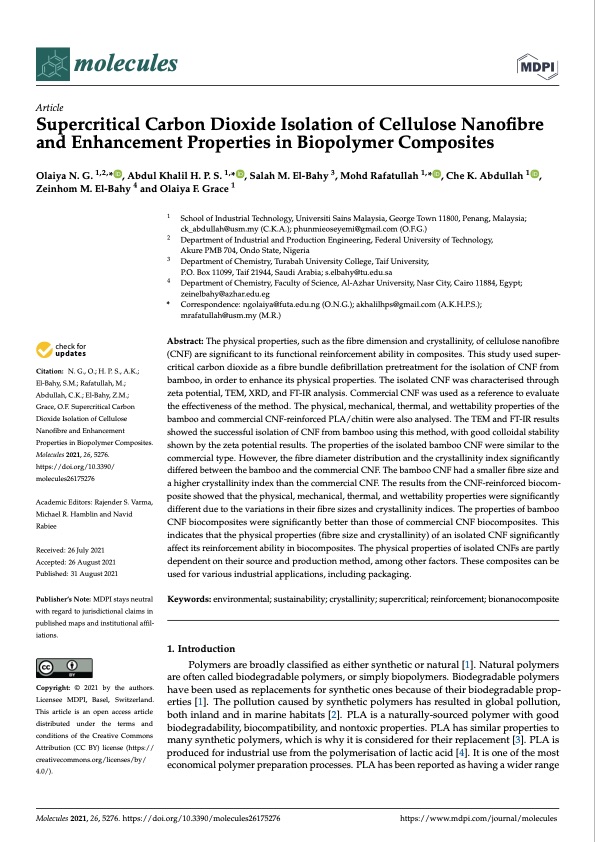
PDF Publication Title:
Text from PDF Page: 001
molecules Article Supercritical Carbon Dioxide Isolation of Cellulose Nanofibre and Enhancement Properties in Biopolymer Composites Olaiya N. G. 1,2,* , Abdul Khalil H. P. S. 1,* , Salah M. El-Bahy 3, Mohd Rafatullah 1,* , Che K. Abdullah 1 , Zeinhom M. El-Bahy 4 and Olaiya F. Grace 1 Citation: N.G.,O.;H.P.S.,A.K.; El-Bahy, S.M.; Rafatullah, M.; Abdullah, C.K.; El-Bahy, Z.M.; Grace, O.F. Supercritical Carbon Dioxide Isolation of Cellulose Nanofibre and Enhancement Properties in Biopolymer Composites. Molecules 2021, 26, 5276. https://doi.org/10.3390/ molecules26175276 Academic Editors: Rajender S. Varma, Michael R. Hamblin and Navid Rabiee Received: 26 July 2021 Accepted: 26 August 2021 Published: 31 August 2021 Publisher’s Note: MDPI stays neutral with regard to jurisdictional claims in published maps and institutional affil- iations. Copyright: © 2021 by the authors. Licensee MDPI, Basel, Switzerland. This article is an open access article distributed under the terms and conditions of the Creative Commons Attribution (CC BY) license (https:// creativecommons.org/licenses/by/ 4.0/). 1 2 3 4 * Correspondence: ngolaiya@futa.edu.ng (O.N.G.); akhalilhps@gmail.com (A.K.H.P.S.); mrafatullah@usm.my (M.R.) Abstract: The physical properties, such as the fibre dimension and crystallinity, of cellulose nanofibre (CNF) are significant to its functional reinforcement ability in composites. This study used super- critical carbon dioxide as a fibre bundle defibrillation pretreatment for the isolation of CNF from bamboo, in order to enhance its physical properties. The isolated CNF was characterised through zeta potential, TEM, XRD, and FT-IR analysis. Commercial CNF was used as a reference to evaluate the effectiveness of the method. The physical, mechanical, thermal, and wettability properties of the bamboo and commercial CNF-reinforced PLA/chitin were also analysed. The TEM and FT-IR results showed the successful isolation of CNF from bamboo using this method, with good colloidal stability shown by the zeta potential results. The properties of the isolated bamboo CNF were similar to the commercial type. However, the fibre diameter distribution and the crystallinity index significantly differed between the bamboo and the commercial CNF. The bamboo CNF had a smaller fibre size and a higher crystallinity index than the commercial CNF. The results from the CNF-reinforced biocom- posite showed that the physical, mechanical, thermal, and wettability properties were significantly different due to the variations in their fibre sizes and crystallinity indices. The properties of bamboo CNF biocomposites were significantly better than those of commercial CNF biocomposites. This indicates that the physical properties (fibre size and crystallinity) of an isolated CNF significantly affect its reinforcement ability in biocomposites. The physical properties of isolated CNFs are partly dependent on their source and production method, among other factors. These composites can be used for various industrial applications, including packaging. Keywords: environmental; sustainability; crystallinity; supercritical; reinforcement; bionanocomposite 1. Introduction Polymers are broadly classified as either synthetic or natural [1]. Natural polymers are often called biodegradable polymers, or simply biopolymers. Biodegradable polymers have been used as replacements for synthetic ones because of their biodegradable prop- erties [1]. The pollution caused by synthetic polymers has resulted in global pollution, both inland and in marine habitats [2]. PLA is a naturally-sourced polymer with good biodegradability, biocompatibility, and nontoxic properties. PLA has similar properties to many synthetic polymers, which is why it is considered for their replacement [3]. PLA is produced for industrial use from the polymerisation of lactic acid [4]. It is one of the most economical polymer preparation processes. PLA has been reported as having a wider range School of Industrial Technology, Universiti Sains Malaysia, George Town 11800, Penang, Malaysia; ck_abdullah@usm.my (C.K.A.); phunmieoseyemi@gmail.com (O.F.G.) Department of Industrial and Production Engineering, Federal University of Technology, Akure PMB 704, Ondo State, Nigeria Department of Chemistry, Turabah University College, Taif University, P.O. Box 11099, Taif 21944, Saudi Arabia; s.elbahy@tu.edu.sa Department of Chemistry, Faculty of Science, Al-Azhar University, Nasr City, Cairo 11884, Egypt; zeinelbahy@azhar.edu.eg Molecules 2021, 26, 5276. https://doi.org/10.3390/molecules26175276 https://www.mdpi.com/journal/moleculesPDF Image | Supercritical Carbon Dioxide Isolation of Cellulose Nanofibre

PDF Search Title:
Supercritical Carbon Dioxide Isolation of Cellulose NanofibreOriginal File Name Searched:
molecules-26-05276-v2.pdfDIY PDF Search: Google It | Yahoo | Bing
Sulfur Deposition on Carbon Nanofibers using Supercritical CO2 Sulfur Deposition on Carbon Nanofibers using Supercritical CO2. Gamma sulfur also known as mother of pearl sulfur and nacreous sulfur... More Info
CO2 Organic Rankine Cycle Experimenter Platform The supercritical CO2 phase change system is both a heat pump and organic rankine cycle which can be used for those purposes and as a supercritical extractor for advanced subcritical and supercritical extraction technology. Uses include producing nanoparticles, precious metal CO2 extraction, lithium battery recycling, and other applications... More Info
| CONTACT TEL: 608-238-6001 Email: greg@infinityturbine.com | RSS | AMP |